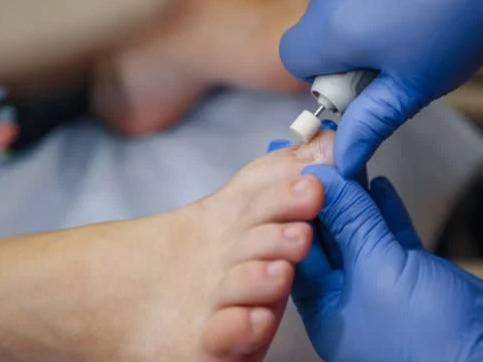Learn more about Fungal Nail
Fungal nail infections, known to doctors as onychomycosis, can affect both toenails and fingernails, but toenail infections are more common.
Nail fungus is often caused by something called ‘dermatophytes’, which are fungi found growing on skin, hair, nails and other bodily surfaces. The primary types of fungi that cause fungal nail infections are dermatophytes, but other fungi such as yeasts and moulds may also be the culprit. As these fungi thrive in a warm and moist environment, common sources of infection come from sharing showers, public changing rooms and pools, and sharing socks and shoes.
Symptoms of fungal nail infections
Fungal nail infections can cause a variety of changes in the affected nail, including:
- white or yellow spots or streaks under the tip of the nail;
- nail thickening and roughness;
- brittle, crumbling nail edges;
- nail discoloration (nails may turn white, yellow or brown);
- separation of the nail from the nail bed; and
- pain and tenderness.
Who’s at risk of fungal infections?
There are several risk factors for higher chance of fungal nails. This includes:
-
- Poor health and hygiene
- Trauma to the nail
- Warmer climate
- Immunosuppressed
- Occlusive footwear
- Increasing age
- Family history
- Communicate bathing or participation in fitness activities
- Repetitive micro traumas to the nails – can lead to invasion by fungi
Tips for self-care to prevent fungal nail infections
To help prevent fungal infections or reinfection the following tips can be applied:
- Maintaining good foot hygiene by washing feet regularly
- Disinfecting your nail clippers after each use
- Changing socks everyday and wearing socks in shoes to prevent re-contamination from the shoe
- Wearing materials on your feet that breathe
- Wear footwear in pool areas and locker rooms
- Only go to nail salons which use sterilised instruments – or see your friendly podiatrist for a medical pedicure
- Reduce the wear of nail polish and artificial nails
If left untreated, the skin underneath your nail can become inflamed and/or painful – and it may retain a foul smell. It is so important to contact a podiatrist at the first indication of a fungal or nail infection, to avoid further complications.
Are you suffering from this condition? At The Chelsea Clinic, we can help. One of our podiatrist can assist and then recommend what treatments are best to get you back on track. Podiatrist South Kensington
Schedule an appointment here or you may call us at +44 (0) 207 101 4000.
We hope you have a feetastic day!
-The Chelsea Clinic and Team




